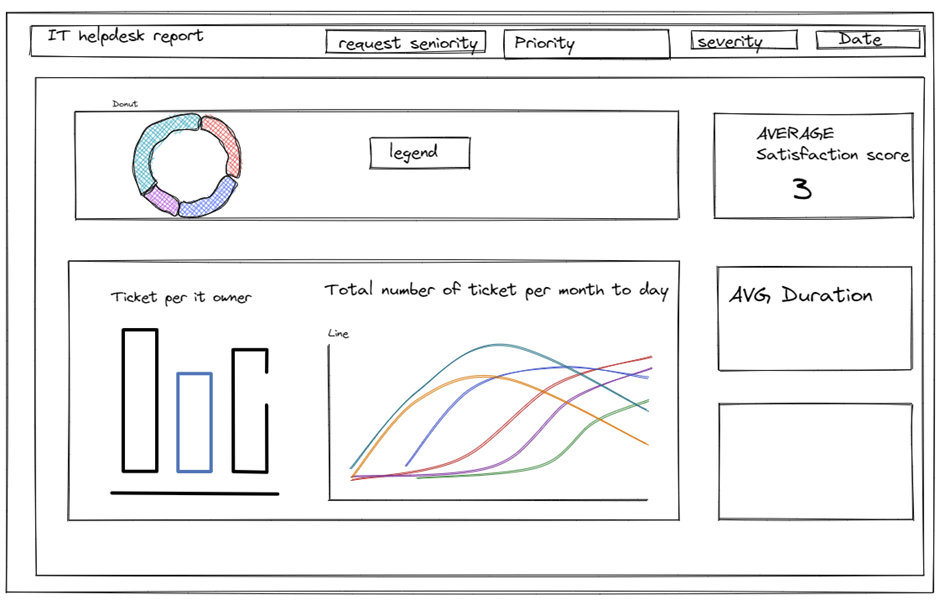These are a few lines I jot down about Friday’s presentation, a trial project which prepares us very well for our first client’s project next week. Keeping in mind all the lessons about project management, request gathering and a bunch of Tableau advance techniques this week, we got to choose an analytic project out of 4 main topics to work on:
- SEO Analytics (website traffic data)
- IT-Help-Desk-Sample (support desk data)
- HR-Analytics (employee information and performance)
- Customer Service (customer service call history and client satisfaction)
I got personally acquainted with the HR-Analytics and Customer Service datasets because these related KPI measures are pretty familiar to people having business background like me. Bearing that in mind, I decided to step out of my comfort zone by trying to deal with a set of new data : IT-Help-Desk.

The first thing to do is to investigate the data and try to understand it. As far as I am concerned, this dataset might come from any company or organization which either specializes in Information Technology or in any specific industry. It contains 10 columns, 100.000 rows ranging from 2013-2017, talking about the status of fixing IT issues in a company. The Ticket column contains ID number of each error log (issue) which has an opened and closed date (counted to seconds). Each issue is raised by requestors whose seniority (hierarchy in the organization’s structure) and solved by IT owner. There are two types of logs: request and issue which are categorized by its technical functions: system, access login, hardware, software. Depending on the priority of the issues, it is determined which one should be most , or least urgently fixed. And finally there is a general evaluation on the scale of 0-3, indicating the satisfaction level of fixing status as per log given by requestors. At first, I mistook the IT owner and requestor ID for a numerical measure because they are encoded with whole integers. Another thing is to verify the scale of satisfaction score ranging from 0 to 3 to see if I fully understand the way they are scored ascending according to the incremental satisfactions (bad to good). Meanwhile 1 indicates the unsatisfaction and 3 for highly satisfaction, the zero score (0) presents the unknown feedback which does not mean neutral but an error or the fact that the person simply does not give feedbacks. Therefore, I decided to exclude those rows having 0-unknown from my satisfaction analysis.
It took me a while to understand the data quality and structure remembering that google and convo are my best friends (which does not seem very wrong). After that I figured out the questions or problems the client is coping with.
1. How can you shorten the fixing issue duration?
2. To do that you need to know, where the errors come from?
3. Which IT owner does a better job than others? Who is the most efficient? Who is the least efficient?
4. By investigating the timeline dimension, you might know when errors normally take place and how many…
Additionally, I sketched my general dashboard layout by Excalidraw, whose features absolutely fancy me. I’d like the donut chart to address my 2nd questions accompanying with the parameter featuring the 2 measures: Fixing duration and Total Ticket. The column chart would definitely concern the 3rd question and the line chart is going to answer the 4th question. A couple of BAN cards provides quick calculation of average satisfaction score and duration keep the viewer right away updated of the overview performance.

After that I came up with a dashboard which looks like this below. You can visit my Tableau Public site and interact with the dynamics measures and dimensions here.
https://public.tableau.com/app/profile/tram7860/viz/IThelpdesk/Dashboard1

Here are things to take away after this experience:
What I am satisfied 😊
· I’m glad that I got on the right track with strategy and big questions…
· The parameters applied are multiple and they work in the first place (so excited because we had just learned the technique earlier this week)
· The set actions date drilldown gave me a hard time to make it work but I just rocked it :D
· Once again I chose a risky path by challenging myself with new stuff and new techniques under time pressure, but isn’t it the right time to experiment ideas and make mistakes? I recommend any schooler to try and make it and fail then remake it since you are learning a lot on the way.
What needs improving :/
· I encountered quite a few problems with formatting and containers in designing my final dashboard in Tableau, for which I shall plan ahead by at least 40 minutes from now on. The layout of a clean, neat and functional dashboard plays a very important role in your presentation.
· My final Dashboard to be presented was too crowded with legends and parameters because I was too greedy in a way that gives users a freedom to choose multiple measures sliced by multiple dimensions at their wish.
· Compulsory steps like adding reference line and sort data are crucial which I unfortunately forgot at the end because it makes it much easier for viewers to take away trends.
· You just have 4 hours to complete a complex assignment involving a lot of steps. Sometimes you have to make sacrifice in terms of ideas. However, don’t turn the lazy button in the brain on because as data analyst we crave for ideas!
P/s: people have different approaches to a project. You may agree or disagree with me on any point but I just hope that my blog gives you a hint of what is going on in a project. Do not worry too much if you could not make it in time or being stressed out because everyone undergoes the same learning process!
